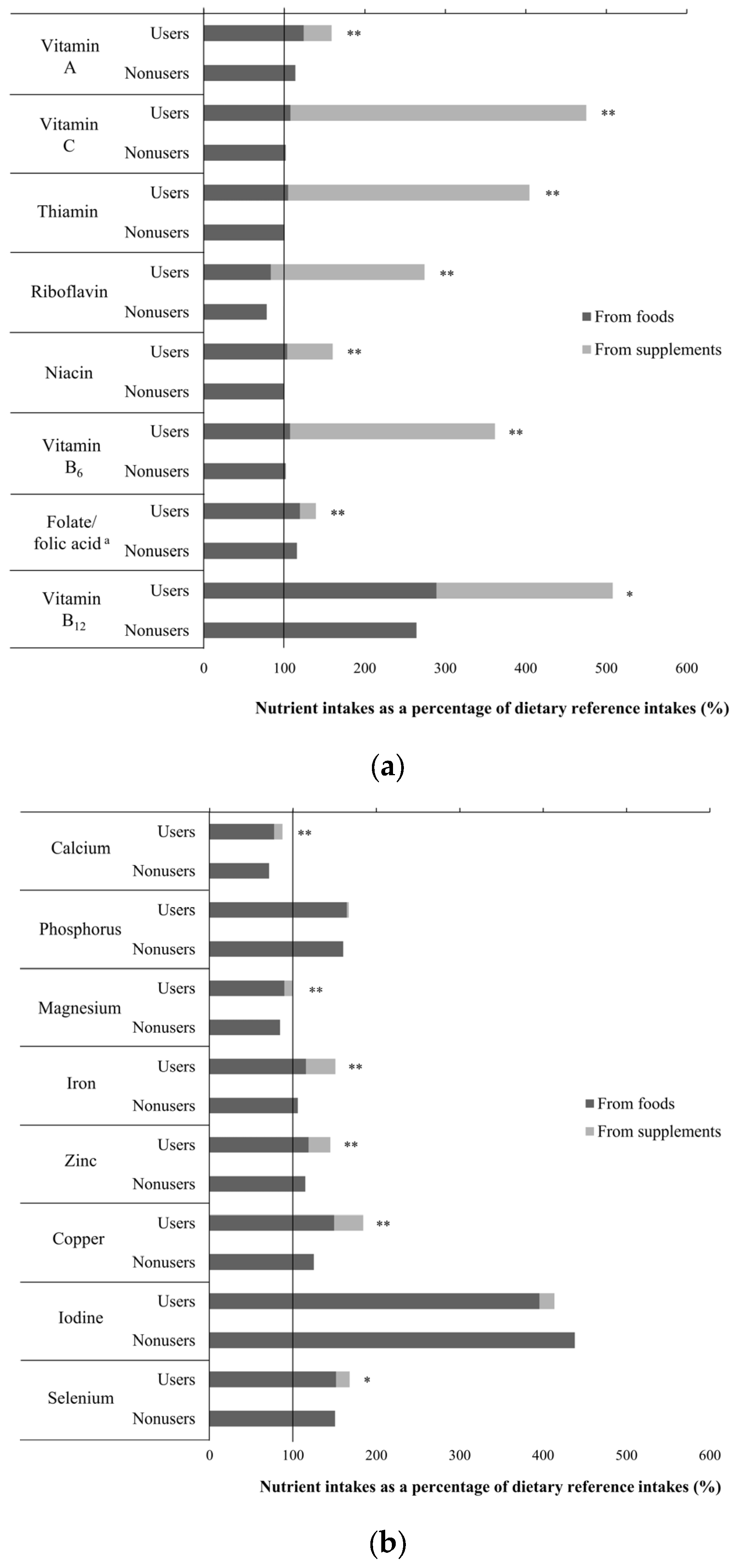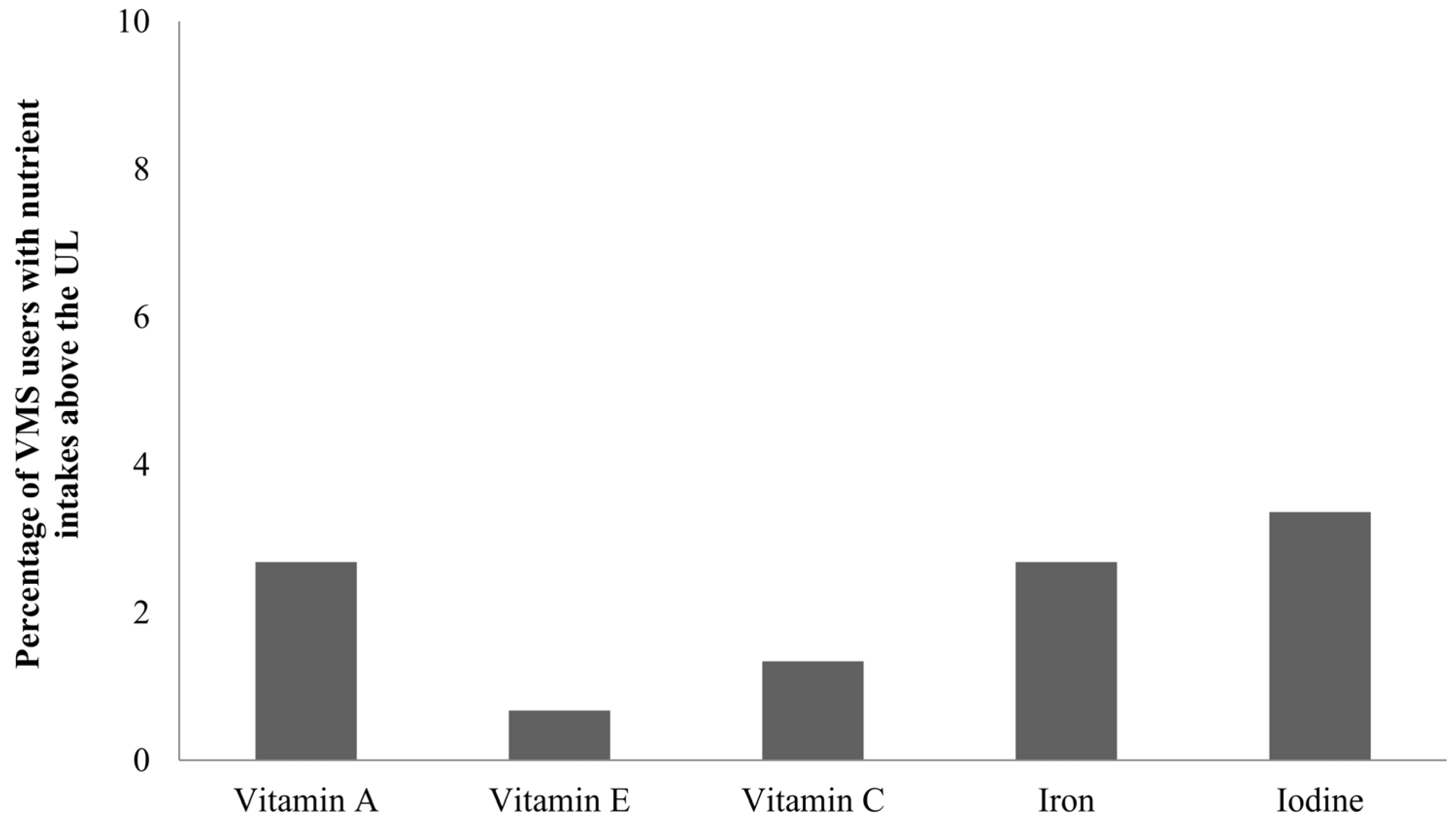Vitamin and Mineral Supplement Use among Korean Adults: Baseline Data from the Trace Element Study of Korean Adults in Yeungnam Area
Abstract
:1. Introduction
2. Materials and Methods
2.1. Study Population
2.2. General Characteristics
2.3. Dietary Information
2.4. Statistical Analysis
3. Results
4. Discussion
5. Conclusions
Acknowledgments
Author Contributions
Conflicts of Interest
References
- Bailey, R.L.; Gahche, J.J.; Miller, P.E.; Thomas, P.R.; Dwyer, J.T. Why us adults use dietary supplements. JAMA Intern. Med. 2013, 173, 355–361. [Google Scholar] [CrossRef] [PubMed]
- Kim, S.H.; Han, J.H.; Keen, C.L. Vitamin and mineral supplement use by healthy teenagers in Korea: Motivating factors and dietary consequences. Nutrition 2001, 17, 373–380. [Google Scholar] [CrossRef]
- Frey, A.; Hoffmann, I.; Heuer, T. Characterisation of vitamin and mineral supplement users differentiated according to their motives for using supplements: Results of the German national nutrition monitoring (nemonit). Public Health Nutr. 2017, 20, 2173–2182. [Google Scholar] [CrossRef] [PubMed]
- Korea Centers for Disease Control and Prevention. Korea Health Statistics 2015: Korea National Health and Nutrition Examination Survey (KNHANES vi-3). Available online: https://knhanes.cdc.go.kr/knhanes/sub04/sub04_03.do?classType=7 (accessed on 11 May 2017).
- Korea Institute Food Safety Management Accreditation. 2015 Analysis of Domestic Market Size Trends of Health Functional Foods. Available online: www.bioin.or.kr/fileDown.do?seq=34593 (accessed on 10 May 2017).
- Commercializations Promotion Agency for R&D Outcomes. Health Functional Food Market Trends. Available online: www.bioin.or.kr/fileDown.do?seq=34761 (accessed on 10 May 2017).
- Dickinson, A.; MacKay, D. Health habits and other characteristics of dietary supplement users: A review. Nutr. J. 2014, 13, 14. [Google Scholar] [CrossRef] [PubMed]
- Fulgoni, V.L., 3rd; Keast, D.R.; Bailey, R.L.; Dwyer, J. Foods, fortificants, and supplements: Where do Americans get their nutrients? J. Nutr. 2011, 141, 1847–1854. [Google Scholar] [CrossRef] [PubMed]
- Blumberg, J.B.; Frei, B.; Fulgoni Iii, V.L.; Weaver, C.M.; Zeisel, S.H. Contribution of dietary supplements to nutritional adequacy in race/ethnic population subgroups in the United States. Nutrients 2017, 9, 1295. [Google Scholar] [CrossRef] [PubMed]
- Kennedy, D.O. B vitamins and the brain: Mechanisms, dose and efficacy—A review. Nutrients 2016, 8, 68. [Google Scholar] [CrossRef] [PubMed]
- Okuyama, M.; Ikeda, K.; Shibata, T.; Tsukahara, Y.; Kitada, M.; Shimano, T. Preoperative iron supplementation and intraoperative transfusion during colorectal cancer surgery. Surg. Today 2005, 35, 36–40. [Google Scholar] [CrossRef] [PubMed]
- Wald, N.J. Folic acid and the prevention of neural-tube defects. N. Engl. J. Med. 2004, 350, 101–103. [Google Scholar] [CrossRef] [PubMed]
- Elam, M.B.; Hunninghake, D.B.; Davis, K.B.; Garg, R.; Johnson, C.; Egan, D.; Kostis, J.B.; Sheps, D.S.; Brinton, E.A. Effect of niacin on lipid and lipoprotein levels and glycemic control in patients with diabetes and peripheral arterial disease: The ADMIT study: A randomized trial. Arterial disease multiple intervention trial. JAMA 2000, 284, 1263–1270. [Google Scholar] [CrossRef] [PubMed]
- Veronese, N.; Watutantrige-Fernando, S.; Luchini, C.; Solmi, M.; Sartore, G.; Sergi, G.; Manzato, E.; Barbagallo, M.; Maggi, S.; Stubbs, B. Effect of magnesium supplementation on glucose metabolism in people with or at risk of diabetes: A systematic review and meta-analysis of double-blind randomized controlled trials. Eur. J. Clin. Nutr. 2016, 70, 1354–1359. [Google Scholar] [CrossRef] [PubMed]
- Lichtenstein, A.H.; Russell, R.M. Essential nutrients: Food or supplements? Where should the emphasis be? JAMA 2005, 294, 351–358. [Google Scholar] [CrossRef] [PubMed]
- Bolland, M.J.; Avenell, A.; Baron, J.A.; Grey, A.; MacLennan, G.S.; Gamble, G.D.; Reid, I.R. Effect of calcium supplements on risk of myocardial infarction and cardiovascular events: Meta-analysis. BMJ 2010, 341, c3691. [Google Scholar] [CrossRef] [PubMed] [Green Version]
- Zheng Selin, J.; Rautiainen, S.; Lindblad, B.E.; Morgenstern, R.; Wolk, A. High-dose supplements of vitamins C and E, low-dose multivitamins, and the risk of age-related cataract: A population-based prospective cohort study of men. Am. J. Epidemiol. 2013, 177, 548–555. [Google Scholar] [CrossRef] [PubMed]
- Boileau, T.W.; Liao, Z.; Kim, S.; Lemeshow, S.; Erdman, J.W., Jr.; Clinton, S.K. Prostate carcinogenesis in N-methyl-n-nitrosourea (NMU)-testosterone-treated rats fed tomato powder, lycopene, or energy-restricted diets. J. Natl. Cancer Inst. 2003, 95, 1578–1586. [Google Scholar] [CrossRef] [PubMed]
- Anderson, J.J.; Kruszka, B.; Delaney, J.A.; He, K.; Burke, G.L.; Alonso, A.; Bild, D.E.; Budoff, M.; Michos, E.D. Calcium intake from diet and supplements and the risk of coronary artery calcification and its progression among older adults: 10-Year follow-up of the multi-ethnic study of atherosclerosis (MESA). J. Am. Heart Assoc. 2016, 5, e003815. [Google Scholar] [CrossRef] [PubMed]
- MacKay, D.; Hathcock, J.; Guarneri, E. Niacin: Chemical forms, bioavailability, and health effects. Nutr. Rev. 2012, 70, 357–366. [Google Scholar] [CrossRef] [PubMed]
- Gibson, R.S. The role of diet- and host-related factors in nutrient bioavailability and thus in nutrient-based dietary requirement estimates. Food Nutr. Bull. 2007, 28, S77–S100. [Google Scholar] [CrossRef] [PubMed]
- National Institutes of Health Office of Dietary Supplements. Nutrient Recommendations: Dietary Reference Intakes (DRI). Available online: https://ods.od.nih.gov/Health_Information/Dietary_Reference_Intakes.aspx (accessed on 6 December 2017).
- Schwalfenberg, G.K.; Genuis, S.J. The importance of magnesium in clinical healthcare. Scientifica 2017, 2017. [Google Scholar] [CrossRef] [PubMed]
- Yoon, S.H.; Kim, H.J.; Oh, K.W. Development of dietary supplement database and nutrient intakes from dietary supplements. Public Health Wkly. Rep. 2015, 8, 210–216. [Google Scholar]
- Korea Centers for Disease Control and Prevention. Use of Dietary Supplements in Korea. 2007. Available online: cdc.go.kr/CDC/cms/content/mobile/43/12143_view.html (accessed on 26 May 2017).
- Park, K.; Seo, E. Association between toenail mercury and metabolic syndrome is modified by selenium. Nutrients 2016, 8, E424. [Google Scholar] [CrossRef] [PubMed]
- Lee, Y.; Park, K. Reproducibility and validity of a semi-quantitative FFQ for trace elements. Br. J. Nutr. 2016, 116, 864–873. [Google Scholar] [CrossRef] [PubMed]
- Park, K.; Seo, E. Toenail mercury and dyslipidemia: Interaction with selenium. J. Trace Elem. Med. Biol. 2017, 39, 43–49. [Google Scholar] [CrossRef] [PubMed]
- Jang, J.; Morris, J.S.; Park, K. Toenail selenium levels and prevalence of dyslipidaemia among Korean adults. Br. J. Nutr. 2017, 118, 473–480. [Google Scholar] [CrossRef] [PubMed]
- Willett, W.W. Nutritional Epidemiology, 3rd ed.; Oxford University Press: New York, NY, USA, 2012; pp. 305–307. ISBN 0190240849. [Google Scholar]
- World Health Organization. The Asia Pacific Perspective: Redefining Obesity and Its Treatment; Health Communications Australia: Sydney, Australia, 2000. [Google Scholar]
- Korea Centers for Disease Control and Prevention. Development of Dietary Supplement Database for Analysis of Intakes of Energy and Nutrients from Dietary Supplement in Korea National Health and Nutrition Examination Survey. Available online: http://cdc.go.kr/CDC//info/CdcKrInfo0201.jsp?menuIds=HOME001-MNU1154-MNU0004-MNU1889&fid=28&q_type=&q_value=&cid=25571&pageNum=1 (accessed on 4 May 2017).
- The Korean Nutrition Society. Dietary Reference Intakes for Koreans First Revision, 2010; The Korean Nutrition Society: Seoul, Korea, 2010; pp. 26–29. [Google Scholar]
- Rural Development Administration National Institute of Agricultural Sciences. 9th Revision Korean Food Composition Table II; Rural Development Administration National Institute of Agricultural Sciences: Wanju-gun, Jeollabuk-do, Korea, 2016; pp. 4–457.
- Ock, S.M.; Hwang, S.S.; Lee, J.S.; Song, C.H.; Ock, C.M. Dietary supplement use by South Korean adults: Data from the national complementary and alternative medicine use survey (NCAMUS) in 2006. Nutr. Res. Pract. 2010, 4, 69–74. [Google Scholar] [CrossRef] [PubMed]
- Kim, J.W.; Lee, S.H.; Kim, J.E.; Han, K.D.; Kwack, T.E.; Kim, B.S.; Kim, J.E.; Jo, E.B.; Park, Y.K.; Lee, K.S. The association between taking dietary supplements and healthy habits among Korean adults: Results from the fifth Korea National Health and Nutritional Examination Survey (2010–2012). Korean J. Fam. Med. 2016, 37, 182–187. [Google Scholar] [CrossRef] [PubMed]
- Kim, Y.J.; Mun, J.A.; Min, H.S. Supplement dose and health-related life style of vitamin-mineral supplement user among Korean middle-aged. Korean J. Community Nutr. 2004, 9, 303–314. [Google Scholar]
- Murphy, S.P.; White, K.K.; Park, S.Y.; Sharma, S. Multivitamin-multimineral supplements’ effect on total nutrient intake. Am. J. Clin. Nutr. 2007, 85, 280S–284S. [Google Scholar] [PubMed]
- Bailey, R.L.; Fulgoni, V.L., 3rd; Keast, D.R.; Dwyer, J.T. Dietary supplement use is associated with higher intakes of minerals from food sources. Am. J. Clin. Nutr. 2011, 94, 1376–1381. [Google Scholar] [CrossRef] [PubMed]
- Bjelakovic, G.; Nikolova, D.; Gluud, L.L.; Simonetti, R.G.; Gluud, C. Mortality in randomized trials of antioxidant supplements for primary and secondary prevention: Systematic review and meta-analysis. JAMA 2007, 297, 842–857. [Google Scholar] [CrossRef] [PubMed]
- Goralczyk, R. Beta-carotene and lung cancer in smokers: Review of hypotheses and status of research. Nutr. Cancer 2009, 61, 767–774. [Google Scholar] [CrossRef] [PubMed]
- Kim, Y.I. Folate: A magic bullet or a double edged sword for colorectal cancer prevention? Gut 2006, 55, 1387–1389. [Google Scholar] [CrossRef] [PubMed]
- Wien, T.N.; Pike, E.; Wisloff, T.; Staff, A.; Smeland, S.; Klemp, M. Cancer risk with folic acid supplements: A systematic review and meta-analysis. BMJ Open 2012, 2, e000653. [Google Scholar] [CrossRef] [PubMed]
- Kang, M.; Kim, D.W.; Baek, Y.J.; Moon, S.H.; Jung, H.J.; Song, Y.J.; Paik, H.Y. Dietary supplement use and its effect on nutrient intake in Korean adult population in the Korea national health and nutrition examination survey iv (2007–2009) data. Eur. J. Clin. Nutr. 2014, 68, 804–810. [Google Scholar] [CrossRef] [PubMed]
- Kang, M.; Kim, D.W.; Jung, H.J.; Shim, J.E.; Song, Y.; Kim, K.; Paik, H.Y. Dietary supplement use and nutrient intake among children in south Korea. J. Acad. Nutr. Diet. 2016, 116, 1316–1322. [Google Scholar] [CrossRef] [PubMed]
- Bailey, R.L.; Gahche, J.J.; Lentino, C.V.; Dwyer, J.T.; Engel, J.S.; Thomas, P.R.; Betz, J.M.; Sempos, C.T.; Picciano, M.F. Dietary supplement use in the United States, 2003–2006. J. Nutr. 2011, 141, 261–266. [Google Scholar] [CrossRef] [PubMed]


| Non-Users | VMS Users | p Value 3 | |
|---|---|---|---|
| N | 437 (74.6) | 149 (25.4) | |
| Sex, men | 219 (50.1) | 58 (38.9) | 0.02 |
| Age, years | 44.6 ± 5.4 | 46.3 ± 5.9 | 0.002 |
| Monthly household income level, KRW | 0.03 | ||
| <3,000,000 | 103 (23.6) | 26 (17.5) | |
| 3,000,000–<5,000,000 | 190 (43.5) | 56 (37.6) | |
| ≥5,000,000 | 144 (33.0) | 67 (45.0) | |
| Education level 4 | 0.2 | ||
| High school graduation or lower | 150 (34.4) | 42 (28.2) | |
| College or university graduation or higher | 286 (65.6) | 107 (71.8) | |
| Smoking status | 0.1 | ||
| Non-smoker | 266 (60.9) | 103 (69.1) | |
| Former smoker | 79 (18.1) | 26 (17.5) | |
| Smoker | 92 (21.1) | 20 (13.4) | |
| Alcohol drinking, yes 5 | 346 (79.2) | 114 (76.5) | 0.5 |
| Body mass index, kg/m2 6 | 0.8 | ||
| Underweight/normal | 230 (52.6) | 82 (55.0) | |
| Overweight | 115 (26.3) | 35 (23.5) | |
| Obese | 92 (21.1) | 32 (21.5) | |
| Medical condition, yes | |||
| Hypertension | 37 (8.5) | 12 (8.1) | 0.9 |
| Hyperlipidemia | 47 (10.8) | 11 (7.4) | 0.2 |
| Diabetes mellitus | 7 (1.6) | 0 (0.0) | - |
| Family history of disease, yes | 279 (63.8) | 150 (70.5) | 0.1 |
| Hypertension | 124 (44.4) | 50 (47.6) | 0.6 |
| Hyperlipidemia | 20 (7.2) | 10 (9.5) | 0.4 |
| Diabetes mellitus | 83 (29.8) | 34 (32.4) | 0.6 |
| Cardiovascular disease | 78 (28.0) | 31 (29.5) | 0.8 |
| Cancer | 122 (43.7) | 45 (42.9) | 0.9 |
© 2018 by the authors. Licensee MDPI, Basel, Switzerland. This article is an open access article distributed under the terms and conditions of the Creative Commons Attribution (CC BY) license (http://creativecommons.org/licenses/by/4.0/).
Share and Cite
Kim, M.; Lee, Y.; Park, K. Vitamin and Mineral Supplement Use among Korean Adults: Baseline Data from the Trace Element Study of Korean Adults in Yeungnam Area. Nutrients 2018, 10, 50. https://doi.org/10.3390/nu10010050
Kim M, Lee Y, Park K. Vitamin and Mineral Supplement Use among Korean Adults: Baseline Data from the Trace Element Study of Korean Adults in Yeungnam Area. Nutrients. 2018; 10(1):50. https://doi.org/10.3390/nu10010050
Chicago/Turabian StyleKim, Minkyeong, Yujin Lee, and Kyong Park. 2018. "Vitamin and Mineral Supplement Use among Korean Adults: Baseline Data from the Trace Element Study of Korean Adults in Yeungnam Area" Nutrients 10, no. 1: 50. https://doi.org/10.3390/nu10010050





